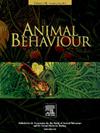Searching day and night: diel hierarchical search patterns in a large marine predator that never stops swimming
IF 2.3
2区 生物学
Q2 BEHAVIORAL SCIENCES
引用次数: 0
Abstract
Animals may demonstrate area-restricted search (ARS) behaviour when encountering prey, where they turn frequently to remain in an area where the probability of finding additional prey is relatively high. We would expect optimally foraging animals to adjust the scale of ARS behaviour to maximize potential prey encounters, which is likely a function of prey distribution and will change over diel cycles. While most predators have distinctive diel activity periods (e.g. only hunt at night), others are more variable. Animals that never stop moving may still show diel activity patterns, but how their search mechanisms change throughout the cycle is less clear. We used biologgers to quantify volume-restricted search (VRS or three-dimensional ARS) by great hammerhead sharks, Sphyrna mokarran, and record potential prey encounter rates. Analysis of 736 dives suggested that VRS dives tended to be shorter, with faster swim speeds, than non-VRS dives. VRS behaviour was detected in 73% of dives, with 44% of those exhibiting VRS at two spatial scales (smaller and larger VRS behaviour within one dive). For dives that showed VRS at one spatial scale, the average radius was 24 ± 23 m; for dives that had VRS at two scales, the average radii were 16 ± 15 m and 45 ± 22 m. Of dives with two spatial scales, 84% showed a hierarchical structure, with smaller VRS dives nested within larger VRS dives. Sharks were more likely to search at larger spatial scales and swim faster during the daytime than at night. Despite this, prey encounter rates were similar during the day and night and sharks were more likely to make stronger jerk movements (potential predatory strikes) at night. Great hammerhead sharks adjusted the spatial scale of hierarchical search patterns and optimal swim speeds across the diel cycle, which may reflect trade-offs between maximizing prey encounter rates and minimizing metabolic costs.
昼夜搜索:一种从不停止游泳的大型海洋捕食者的分层搜索模式
当遇到猎物时,动物可能会表现出区域限制搜索(ARS)行为,在那里它们经常转向停留在发现额外猎物的可能性相对较高的区域。我们预计最佳觅食动物会调整ARS行为的规模,以最大限度地增加潜在的猎物遭遇,这可能是猎物分布的函数,并将随着饮食周期而变化。虽然大多数捕食者都有独特的昼夜活动周期(例如,只在夜间捕猎),但其他捕食者的变化更大。从不停止移动的动物可能仍然表现出死亡的活动模式,但它们的搜索机制在整个周期中是如何变化的就不太清楚了。我们利用生物学家量化了双髻鲨(Sphyrna mokarran)的体积限制搜索(VRS或三维ARS),并记录了潜在的猎物遭遇率。对736次潜水的分析表明,与非VRS潜水相比,VRS潜水往往更短,游泳速度更快。在73%的潜水中检测到VRS行为,其中44%的潜水在两个空间尺度上表现出VRS(一次潜水中较小和较大的VRS行为)。对于在一个空间尺度上显示VRS的潜水,平均半径为24±23 m;对于具有两个尺度的VRS的潜水,平均半径为16±15 m和45±22 m。在两个空间尺度的潜水中,84%显示出分层结构,较小的VRS潜水嵌套在较大的VRS潜水中。鲨鱼更有可能在更大的空间尺度上搜索,白天比晚上游得更快。尽管如此,在白天和晚上,鲨鱼遇到猎物的几率是相似的,而且鲨鱼在晚上更有可能做出更强烈的抽搐动作(潜在的掠食性攻击)。双髻鲨在整个生命周期中调整了分层搜索模式的空间尺度和最佳游动速度,这可能反映了最大化猎物遭遇率和最小化代谢成本之间的权衡。
本文章由计算机程序翻译,如有差异,请以英文原文为准。
求助全文
约1分钟内获得全文
求助全文
来源期刊

Animal Behaviour
生物-动物学
CiteScore
4.60
自引率
8.00%
发文量
236
审稿时长
10.2 weeks
期刊介绍:
Growing interest in behavioural biology and the international reputation of Animal Behaviour prompted an expansion to monthly publication in 1989. Animal Behaviour continues to be the journal of choice for biologists, ethologists, psychologists, physiologists, and veterinarians with an interest in the subject.
 求助内容:
求助内容: 应助结果提醒方式:
应助结果提醒方式:


